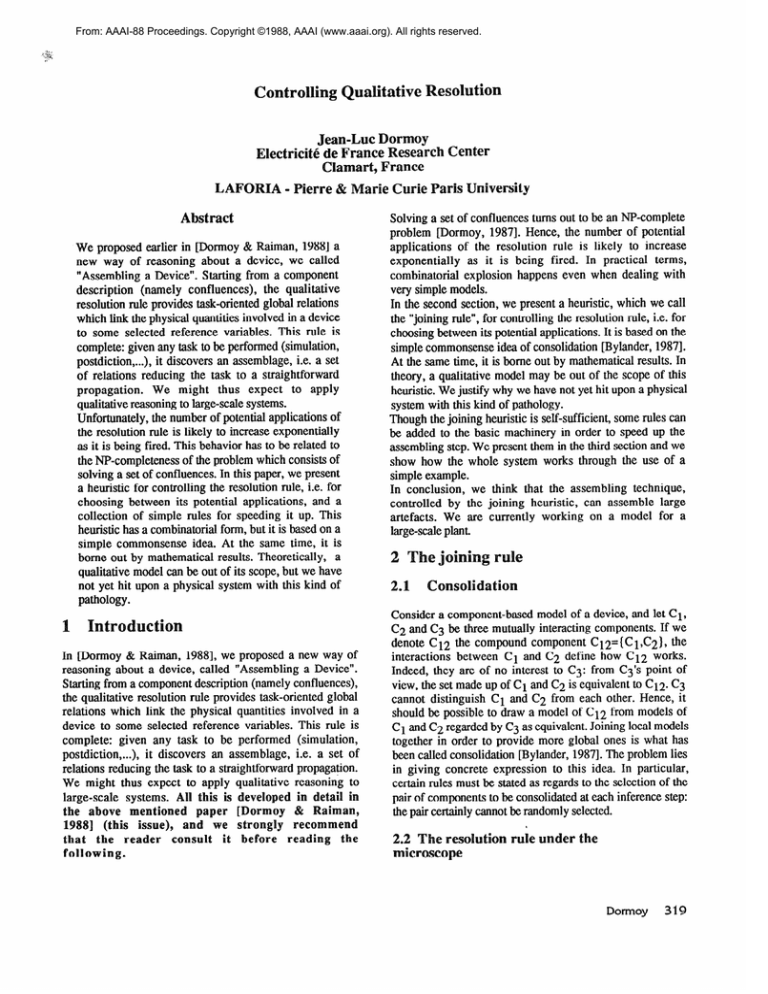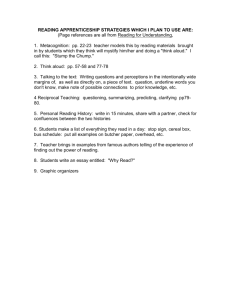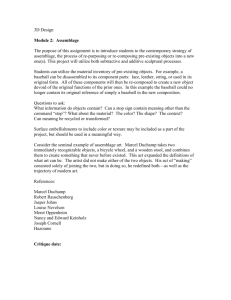
From: AAAI-88 Proceedings. Copyright ©1988, AAAI (www.aaai.org). All rights reserved.
Controlling Qualitative Resolution
Jean-Luc Dormoy
Electricit de France Research Center
Clamart, France
LAFQRIA - Pierre &
Abstract
We proposed earlier in [Dormoy & Raiman, 19881 a
new way of reasoning about a device, we called
“Assembling a Device”. Starting from a component
description (namely confluences),
the qualitative
resolution rule provides task-oriented global relations
which link the physical quantities involved in a device
to some selected reference variables. This rule is
complete: given any task to be performed (simulation,
postdiction,...), it discovers an assemblage, i.e. a set
of relations reducing the task to a straightforward
We might thus expect to apply
propagation.
qualitative reasoning to large-scale systems.
Unfortunately, the number of potential applications of
the resolution rule is likely to increase exponentially
as it is being fired. This behavior has to be related to
the NP-completeness of the problem which consists of
solving a set of confluences. In this paper, we present
a heuristic for controlling the resolution rule, i.e. for
choosing between its potential applications, and a
collection of simple rules for speeding it up. This
heuristic has a combinatorial form, but it is based on a
simple commonsense idea. At the same time, it is
borne out by mathematical results. Theoretically, a
qualitative model can be out of its scope, but we have
not yet hit upon a physical system with this kind of
pathology.
In [Dormoy & Raiman, 19881, we proposed a new way of
reasoning about a device, called “Assembling a Device”.
Starting from a component description (namely confluences),
the qualitative resolution rule provides task-oriented global
relations which link the physical quantities involved in a
device to some selected reference variables. This rule is
complete: given any task to be performed (simulation,
postdiction,...), it discovers an assemblage, i.e. a set of
relations reducing the task to a straightforward propagation.
We might thus expect to apply qualitative reasoning to
large-scale systems. All this is developed in detail in
the above mentioned
paper [Dormoy & Raiman,
19881 (this issue), and we strongly
recommend
that the reader consult
it before reading
the
following.
arie Curie Paris University
Solving a set of confluences turns out to be an NP-complete
problem [Dormoy, 19871. Hence, the number of potential
applications of the resolution rule is likely to increase
exponentially
as it is being fired. In practical terms,
combinatorial explosion happens even when dealing with
very simple models.
In the second section, we present a heuristic, which we call
the “joining rule”, for controlling the resolution rule, i.e. for
choosing between its potential applications. It is based on the
simple commonsense idea of consolidation [Bylander, 19871.
At the same time, it is borne out by mathematical results. In
theory, a qualitative model may be out of the scope of this
heuristic. We justify why we have not yet hit upon a physical
system with this kind of pathology.
Though the joining heuristic is self-sufficient, some rules can
be added to the basic machinery in order to speed up the
assembling step. We present them in the third section and we
show how the whole system works through the use of a
simple example.
In conclusion, we think that the assembling technique,
controlled by the joining heuristic, can assemble large
artefacts. We are currently working on a model for a
large-scale plant.
2.
Consider a component-based model of a device, and let Cl,
C2 and C3 be three mutually interacting components. If we
denote C 12 the compound component Cl2= {C 1 ,C2), the
interactions between Cl and C2 define how Cl2 works.
Indeed, they are of no interest to C3: from C3’s point of
view, the set made up of Cl and C2 is equivalent to C12. C3
cannot distinguish Cl and C2 from each other. Hence, it
should be possible to draw a model of Cl2 from models of
Cl and C2 regarded by C3 as equivalent. Joining local models
together in order to provide more global ones is what has
been called consolidation [Bylander, 19871. The problem lies
in giving concrete expression to this idea. In particular,
certain rules must be stated as regards to the selection of the
pair of components to be consolidated at each inference step:
the pair certainly cannot be randomly selected.
e resolution rule under the
2.2
microscope
Dam-toy
319
b
f
sv
way for confluences E 1 and E2.
If El and E2 are the respective models of components Cl
and C2, then E 12 is a proper model for CI2. Cl and C2
are joined.
This rule can be applied recursively. Indeed, a variable y
different from x and involved solely in E 1, E2 and a third
confluence belongs to exactly two confluences after the
joining rule has been fired. Therefore, the joining rule might
choose to eliminate it at a next step. This means that a
compound component can be joined in turn to another atomic
or equally compound component.
Figure 1: Joining two components
2.4
In a confluence-based model, C 1 and C2 interact through their
common variables. Hence, building a model for Cl2 means
providing confluences by eliminating them. Consider a
variable involved in both Cl and C2 models. If it is involved
in some other component model, then it must appear in a
model of Cl2 (like variable y in Fig. 1). But if it is not, then
it must be completely eliminated (like variable x in Fig. 1).
The resolution rule (Fig* 2) seems to tackle this problem, but
we must examine what it accomplishes closely.
Let xr yI 2, a, b be qualitative
quantities
such that
x+y=a
and -x+z=b
If x is different
from ?, then
=a+b
Y+Z
Figure 2: The qualitative resolution rule
Consider a simple case (but this case happens more often than
not), when both CI and C2 models are made up of a single
confluence, say respectively E 1 and E2. Let x be a variable
involved in both, and assume that the resolution rule applies
to E 1 and E 2 and so eliminates x. Then we get a new
confluence, say E12, which is global to C12. Any other
variable involved in E 1 or E 2, or both, will belong to E 12
as well. But it is not true in general that El2 is equivalent to
E 1 and E2. For instance, if the model of another component
C3 mentions x explicitely, then E 12 is certainly not a
proper model of Cl 2. But the equivalence should hold
whenever x is exclusively involved in El and E2.
2.3
Joining
two components
Previous remarks provide a heuristic rule for choosing
between the potential applications of the resolution rule at
each inference step:
Joining rule: Let 45 be a set of confluences corresponding
to a component-based
description of a device. If the
resolution rule applies to confluences E 1 and E2 by
eliminating variable x, and if x is exclusively involved in
E 1 and E2, then choose this application. An equivalent
model (as far as variables different from x are concerned) is
obtained by substituting confluence E 1 2 produced in this
320
Common Sense Reasoning
A mathematical
justification
The choice heuristic contained in the joining rule conditions
has been justified above by some commonsense arguments. It
needs no mathematical proof. But the conclusion, which
claims that substituting E 1 2 for E 1 and E2 provides an
equivalent model for the variables different from X, does need
one. We have proved that this is true for square systems, i.e.
when the number of confluences is equal to the number of
internal variables. Indeed, it can be proved in this case that,
starting from task-oriented confluences, all the pieces of
task-oriented assemblages (involving variables different from
x) that can be drawn from the initial model can be drawn after
the joining rule has been fired as well. We do not give the
proof here, because it is too long and requires mathematical
notions which are beyond the scope of this paper. It can be
found in [Dormoy, 19871.
We have proved further.
Let I5 be a non decomposable set of confluences, and x a
variable involved exactly in two confluences, say El and
E2. If the resolution rule does not apply to E 1 and E2 by
eliminating X, then no piece of assemblage involving a
variable different from x can be drawn from @.
A set of confluences @ is said to be decomposable if it
contains a subset @” involving variables that are not
mentioned in @ - @‘. In practical terms, if E happens to be
decomposable, then one considers 3E’ first. This is what
Iwasaki and Simon [1986] called causal ordering. The
problem comes down to the study of non decomposable sets
of confluences. In concrete terms, a “loop of components” is
not decomposable. Efficient algorithms have been described
for decomposing a set of equations (see for example [Trave &
Kaskurewicz, 19861).
This second property is important: it states what happens
when two components are about to be joined, but ultimately
cannot be so. The conclusion seems natural: finding a piece
of assemblage for a variable different from x requires
eliminating x at some step. This property can be viewed as
the “negative part” of the joining rule (it states when joining
is not possible).
However, it must be pointed out that this second property
never applies when the qualitative model is stationary. A
stationary qualitative model based on confluences can be
formally defined as having a fz.dZqualitative rank (the
qualitative rank of a system is defined as the maximum
of its column vectors which are qualitatively
This means that the single solution when all
the reference variables are 0 is 0. In physical terms, this
means that all the internal variables remain steady when the
reference variables do. This is why we call it a stationary
model. It can be proved that an assemblage can be drawn from
a non decomposable model iff it is stationary. The model
example presented in this paper is stationary.
number
independant).
e joining rule fail?
The system presented here has been tried in various examples,
stemming from different physical areas: electronic circuits,
thermodynamic systems (e.g., the pressurizer of a PWR
nuclear power plant),.... It never failed in yielding an
assemblage in a straightforward way. So, it is justified to ask
whether this method is complete, i.e. always leads to an
assemblage. If this is the case, then any model which can be
assembled must involve at least one variable belonging to
exactly two confluences.
Indeed, the joining rule may fail. Some models can be
assembled, but have no variable belonging to less than 3
confluences.
We shall not discuss the underlying
mathematics, but previous work related to this question has
to be mentioned.
Similar issues were studied more than twenty five years ago
by mathematical economists. They led to many mistakes.
Lancaster [1962] claimed that the matrix of any square system
having a determinate value turns out to be deducible from the
form:
1
r+-o...o
It can be shown that Lancaster’s and Gorman’s forms, plus
this last form, are the only generic forms of 4x4 matrices.
There are 6 basic forms of 5x5 matrices, but we do not know
how many there are for nxn matrices with n>S. A generalized
control for qualitative resolution is strongly related to these
topics.
Let’s go back to the real world. The fact that the joining rule
works without trouble within a physical model can be
justified by a commonsense argument: there must be a
variable linking two components, but not involved in the
interaction with any other component.
tatio
Here follows a demonstration of how the joining rule is
implemented. Though it is self-sufficient, some rules can be
added in order to speed up the assembling step. They all turn a
set of confluences into an equivalent one. Their advantage lies
in the fact that they reduce the number of confluences or of
variables. New confluences are produced by some of them:
they can also be produced by the resolution rule. However,
their complexity is polynomial. Hence, it is worth firing
them first.
The set of confluences considered at the current step will be
denoted E in the overall section.
ask machinery
Let IEO be the qualitative model to be assembled. Perform
choice, step 0.
Now, a system having a determinate value can be assembled.
This would imply that the joining rule is complete in the
squarecase.
Two years later, Gorman [1964] showed that this is wrong by
producing the following counter-examples:
LJ
1 J
Choice, step i: Select within the current set of
confluences Bi a variable x such that:
x is involved in exactly two confluences of @iv
x has not been yet selected at step i,
there is a variable different from x involved in
which has not been yet assembled.
Joining rule (JR), step i : Let x be the selected variable,
and E 1 and E 2 the confluences involving x. Then,
eliminate x by mean of the resolution rule. This produces
Set
confluence
the
El2
*
@*1+1 <--IEi-{ElrE2}U{E12}.PcrfOrmchoice,step
i+l.
N2
0
+++++
Nl and N2 are square matrices. They have a single line in
common. They are themselves supposed to be Lancaster’s or
Gorman’s matrices. Gorman claimed in a footnote that he had
proved that all the determinate matrices are deducible from
this generic form. Unfortunately,
this is wrong, too, as
shown by the counter-example:
Backtracking, step i: Make a new choice, step i. If no
such choice is possible, and if i is different from 0, then
go back to step i-l.
In addition, as soon as a confluence involving a single
variable is produced, the corresponding piece of assemblage is
kept and the backtracking step is performed. The “negative
part” of the joining rule may also be added.
3.2
Simplification
rules
Dormoy
321
3.2.1
Equality
rule
Let ax+by=O
(e ) be a confluence in @, such that a and b
are both different from 0. Then x=-aby, and the expression
-aby can be substituted for x in all the confluences of iE
different from (e ) . Then discarding (e ) provides an
equivalent set of confluences.
This rule is of great practical importance: it discards a variable
and at least one equation. At the same time, there are often in
physical systems confluences having the pattern of (e ) .
Some examples are: the valve of the pressure regulator, the
form of Ohm’s law involving voltage drop, or a confluence of
a component involving three variables and corresponding to a
“connected-to-ground” component.
Example: (from CE-feedback, see Fig. 4 below)
- [ dig2
] =O
one
draws
From
[ dVFP]
[dVFp] = [ dig2
1. [dig2 ] can be replaced by
[dVFpl.
3.2.2
Ritschard’s
rule
In the field of economics, Ritschard proposed [1983] a more
constrained form of the resolution rule, but leading to a more
informative conclusion (the divergences from the resolution
rule are underlined):
Let x+El=a
(Cl) and -x+Ez=b
(C2) be two
confluences, where x is a variable and El and E2 have no
variable with opposite coefficients in common. Assume
that all the variables involved in E2 are also involved in
~1 (though the reverse may not be the case). Then
E yafb
(C3 ) is a valid confluence, where E3 is the
same expression as E 1+E2, but with no repeated variable.
Moreover. if a+b=b. then substituting confluence ((~31
for confluence
! c 11 provides an eauivalent set of
confluences.
This rule eliminates the occurrence of a variable in an
equation. Its complexity is polynomial, but it costs much
more than the other rules presented here (including the joining
rule). Nevertheless, it is worth examining it at the beginning
of the assembling step, for it may cause the application of the
equality rule (see above) or the single-occurrence-elimination
rule (see below).
Example: (from the pressure regulator, see [Dormoy &
Raiman, 19881 - this issue)
This rule applies to the pressure regulator after the
equality rule substituted -[dP4] for [dAl.Let (Cl)
and (C2 ) be the two confluences:
[dP2l-[dP3l-[dP4l-[dQl~~
(6)
[dP31-W41-
until assembling is completed.
Indeed, ( e ) is not a constraint upon the variables involved in
(e) and diffe rent from x: whatever value they are assigned,
an assignment to x that satisfies confluence (e ) can always
be found.
Example: After previous application of Ritschard’s rule,
[ dP 3 ] occurs only in confluence ( 3 ) . Hence [ dP 3 ]
and (3) can be discarded.
3.2.4
Assemblage
(7)
k@2l-Wql-[dQl=O
rule
If a variable x occurs in a single confluence
( e)
involving at least two variables, then discard x and W
322
Common Sense Reasoning
(Al)
W2l=Wll+W51
This would lead to a new form of confluence ( 1) :
-[dQl=?Wll+M’51
Afterwards, no piece of assemblage could be deduced for
[dQl .
Example: (from the pressure regulator)
This rule draws a piece of assemblage for [ dP 3 ] from
confluence ( 3 ) and pieces of assemblage (A2 ) and
(A3):
W3l=W~l+?[dp5l
(A51
The last part of the rule makes sure that this is a proper
piece of assemblage.
(3)
[dQl=O
Single-occurrence-elimination
rules
These rules generalize the basic propagation rules in order to
deal with task-oriented confluences.
Let (e) be a confluence involving a single internal
variable x. Then deduce the corresponding piece of
assemblage.
This rule simply achieves the goal of the assembling step.
Let x=f(wl,... , wD) be a piece of assemblage, and
( e ) a confluence ihvolving x. Then replace x by
wr,) , provided that this adds no new ?
f(qr...,
coefficient to any reference variable or that (e ) has been
discarded by the single-occurrence-elimination
rule. Any
global relation deduced after this replacement will be a
piece of assemblage under the usual conditions.
Adding a new ? coefficient to some reference variable could
make assemblage deduction impossible. For instance, [ dP 2 ]
should not be replaced by [ dP I]+ [dP 5 ] as soon as the
resolution rule produces the piece of assemblage:
Then [ dP 3 ] can be eliminated in confluence ( 6 ) , and
confluence ( 6 ) can be replaced by confluence ( 7 ) :
3.2.3
propagation
iF
iB2
Transistor Q 1:
[dvIl-[diBl=O
LdvIl-[diEI]=
Transistor Q2:
[dVc1E2l-[dic+O
[dvIl-[diC1]=O
[dVc1E2]-[diBl]-G
Ohm’s law:
[dvI]-[dvFp]-[diF]=O
[dv,2]-[dvFp]-[dvClE2]"0
[dvFpl-[dig21=0
[dvC1l-[diCCl=O
Ohm(I,FP)
Ohm(E2,FP)
Ohm(FP,Ground)
Ohm(C1,CC)
KCL:
[diI]-[diB]-[di,]-0
[diCl]-[diCCl]-[di,,]=O
[di,2]-[diF]-[di,l]-0
KCL(1)
KCL(C1)
KCL(FP)
Definition of drop of potential:
[dvclE21
- [dvcll
+[dvE2]=0
PD(Cl,E2)
Figure 4: CE-Feedback and its loop model
We present here how the “loop” in CE-feedback (Fig. 4) [De
Kleer, 19841 can be assembled using the joining rule and the
simplification rules afore-mentioned. Some inference steps are
illustrated by diagrams. They are intended to show the
similarity between the way the system joins the components
and the way an engineer would.
The equality rule applies first. It gives:
[dvIl=[di,]=-[diCl]=[diEll
~d~~~~~l=~di~~l=-~di~~l=~d~~~l
[dvppl=[dig21
After replacements have been performed, we get:
Ohm(I,FP)
[dVI]-[dVFp]-[diF]=O
[dvE2]-[dvFp]-[dvCl~2]"0Ohm(E2,Fp)
KCL(1)
-[dvI]-[diF]=-[diI]
-[dvI]-[dvcl]-[dVClE2]"0
KCL(C1)
[dVFp]-[diF]-[dVClE2]=0
KCL(FP)
[dVclE21- [dvcll +[dVE2]=0 PD(Cl,E2)
The joining rule now applies. The steps are:
Choice, step 0
[dvcl] Sekkd,KCL(Cl)-PD(Cl,E2)
JR, step 0
-[dV,l-[dV,2l-~dVc1E21”0
Choice, step 1
(14)
[dVE2] Selected,Ohm(E2,FP)+(14)
JR, step 1
-[dvI]-[dvFp]-[dvClE2]-0
(15)
Let’s sum up the situation. The current model at step 2 is:
[dVI]-[dVFp]-[diF]=O
-[dvI]-[diF]=-[diI]
[dvFpl[d+l[dvc1E21”0
-[dvI]-[dvFp]-[dvClE2]=0
Ohm(I,FP)
KCL(1)
KCL(FP)
(15)
The joining rule goes on firing:
Choice, step 2
[dVClE2] selected, KCL(FP)-(15)
JR, step 2
[dvI]+[dvFp]-[diF]=O
(16)
Choice, step 3
[dVFp] Selected,Ohm(I,FP)-(15)
JR, step 3
[dvI]-[diF]=O
(16)
At this step, the equality rule applies, and deduces that
[dvIl
and IdiF] areeqL&: [dvI]=[diF].Propagating
this equality in KC L ( I ) leads to the first pieces of
assemblage: [dvI]=[diF]=[diI].
Backtracking to step 2, the second assemblage propagation
rule applies. The set of confluences at step 2 reduces to:
KCL(FP)
[dvFpl-[dvClE2l=[diI]
(15)
- [dvFpl[dvc1&”
[diIl
The joining rule applies again:
Choice, step 2
[dVFp]SeleCted,KCL(FP)+(15)
JR, step 2
[dVc1E2l”[d+l
and gets a new piece of assemblage: 1dVC lE2 ]= [diF ].
One can check that no other informative piece of assemblage
can be obtained.
If not controlled, qualitative resolution leads to combinatorial
explosion. But the fact that qualitative models stem from
real-world devices prevents qualitative resolution from
meeting the fate of resolution in logic. The heuristic control
presented here is strongly related to the structural properties of
a sane device.
We have tried our system in examples corresponding to
different physical areas. However, these were all small
devices. Nevertheless, we believe that the assembling
technique, controlled by the joining heuristic, could assemble
some larger artefacts. We are currently working on a model of
a large-scale plant.
[Bylander, 19871 Tom Bylander. Using consolidation for
reasoning about devices. Technical Report of the Ohio State
University, March 1987.
[De Kleer, 19841 Johan de Kleer. How circuits work.
Artificial Intelligence Vol.24 n”l-3, December 1984.
[Dormoy, 19871 Jean-Luc Dormoy. Resolution qualitative:
completude, interpretation physique et controle. Mise en
oeuvre dans un langage a base de regles: BOOJUM. Paris 6
University Doctoral Thesis, December 1987.
[Dormoy & Raiman, 19881 Jean-Luc Dormoy and Olivier
Raiman. Assembling a device. AAA188.
[Gorman, 19641 W. M. Gorman. More scope for qualitative
econonomics. Review of economic studies XXX1 pp 65-68,
1964.
[Iwasaki $ Simon, 19861 Y. Iwasaki & H. A. Simon.
Causality in device behavior. Artificial Intelligence Vol. 29
n”1, July 1986.
Lancaster, 19621 K.J. Lancaster. The scope of Qualitative
economics. Review of economic studies XXIX n”2,1962.
[Ritschard, 19831 Gilbert Ritschard. Computable qualitative
comparative statics techniques. Econometrica Vol. 51 n”4,
July 1983.
[TravC & Kaskurewicz, 19861 Louise TravC & Eugenius
Kaskurewicz. Qualitative solutions of linear homogeneous
systems. Internal report of the LAAS-CNRS at Toulouse
(France), October 1986.
Dormoy
323





